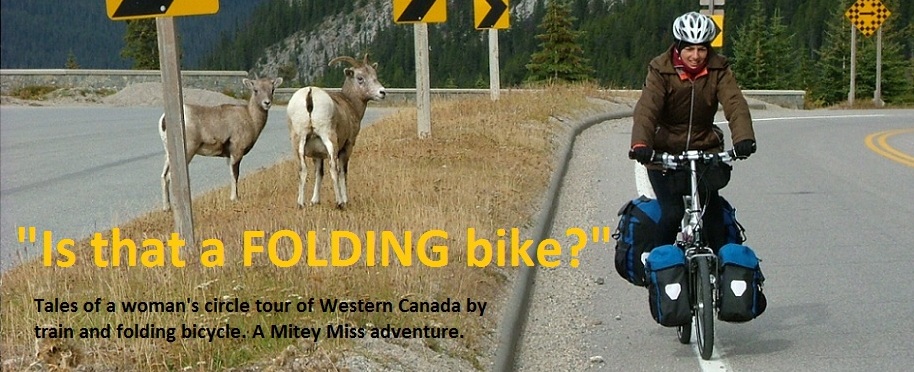A few hours after our walk with poet Paulette-Blanchette-Dube,
Michelle and I return to the Pyramid Bench trailhead for a completely different kind of walk: Marci DeWandel is a "communications officer" with Jasper National Park. She has a particular involvement with their controversial "Jasper Trails Project" ~ an effort by Parks decision-makers to work with the community to measure, study and design a "sustainable trail network" within the park's boundaries.Before leading us on a hike, Marci points to a map of the park that she'd pined up to a trailhead kiosk. Twelve of us peer at the ribbons of yellow, red and blue on the map. "There are over 200 kilometres of official, multi-use trails in Jasper National Park," she says, "but there are also approximately 150 kilometres of unofficial trails."
An "official" trail is a path that currently exists because it was created over the years by park staff or old logging vehicles. "Multi-use" means that just about any trail might be used by hikers, mountain bikers, or indigenous wildlife at the same time.
An "unofficial" trail is on that has been cut by erosion, short-cutting or a combination. Marci points to a steep trail that cuts across the V of a switchback. "Most likely that was created by mountain bikes going downhill," she observes neutrally.
Surprisingly, the heaviest users of the official and unofficial trails are locals, not tourists. She points to a cartooned "Slow Down" sign at the crest of another downhill, inked by local artist Thomas Dolt. Marci shrugs, "sometimes you've got to use what'll work; so we use a little humour to get the message across."
We step further up the trail and pause at a clearing that offers a clear view of the town jasper, the Athabasca River and the Malign Range rising behind it. Marci says that the Jasper Trail Project is working with all community users (such as the Jasper Mountain Bike Association) to ensure that trails are viable, but users must also remember that the trails that criss-cross the valley we see below act as corridors for wildlife to traverse the area for food, shelter and mating.
The narrowness of the Jasper's valley has meant that the town's had to limit its spread, but it also means wildlife must sometimes come closer to humans than either inhabitant would like. The town of Jasper is ~ after all ~ inside a national park.
Someone in the group asks Marci what exactly Parks mean when they use the term "sustainable." It's two things, answers Marci. It's a trails that lasts ~ over time, weather and usage. And it's a trail that is shared by wildlife and allows for their use. She mentions the Project's use of on-trail cameras that records "occurrences" of trail usage by humans and wildlife.
"You'd be surprised," she comments, "we'll get images of a trail runner on a particular path, and not more than two minutes later a bear will travel along the same path." In the peak season, a popular trail can show up to 300 occurrences in a day. We look at each other and the stream bridge we've paused on, and quickly continue our walk.
Marci guides the group onto Trail 2, then 2A. In comparison to the leaf-covered, natural look of the earlier section, the "improved" section looks like a construction site: it's at least 2 metres wide, has gullies on either side, and is obviously comprised of layers of rock, grave, and dirt.
"We actually got some trail-building suggestions from the mountain bikers," says Marci of the path. "It's resistant to wear, drains well and over time the ditches will fill in with plants and look more natural."
We bandy about the question of who causes more damage to a trail ~ mountain bikes or horses ~ so I ask Marci directly. "Actually," she says, "a badly drained trail can cause the most damage. Over time it gets wider and muckier; then users cut a parallel rail to avoid it; it gets mucky and one slope can have three or four trails on it ~ when one well-designed, well-drained trails would solve all of that."
The walk's been a real thought-provoker and I've been especially impressed by how articulate and fair-minded Marci's discussion has been about an endeavor that has raised some ire in the community it's designed to appease.
Michelle sends me a look, and I nod in agreement: now that we've explored the local trails, let's go explore the local brew pub. We wish Marci good luck on the Jasper Trails Project and point the bikes towards Connaught Street and the Jasper Brewing Company.
